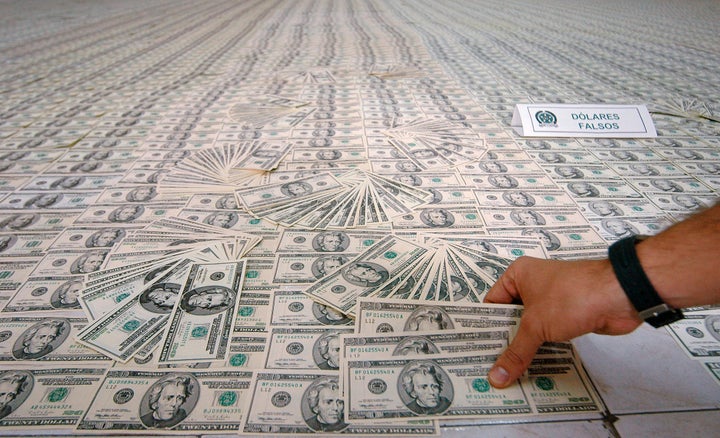
(Mike Dolan) - Years of angst about a self-feeding downward spiral of the U.S. dollar and Treasury bond prices were swept aside when the credit crisis blew up four years ago, but there may well be unfinished business.
The dollar and Treasury bond prices actually surged when the last decade's boom went bust, banks foundered and both the safety and cash-like liquidity of U.S. debt became premium for those fearful of systemic collapse.
Yet with little fanfare this year -- even as a euro debt crisis intensified, Middle East unrest raged, oil surged and Japan's earthquake hit -- investors declined to afford the dollar safe haven status and let it fall to its lowest since the gold-based Bretton Woods system broke down in 1973.
Measured by the inflation-adjusted cut of the Fed's broad trade-weighted index, the greenback is now down more than 15 percent since the height of the recent global recession. And it's three percent below a floor set three times over the past 38 years of floating exchange rates -- in 1978, 1995 and 2008.
So for all the seeming chaos elsewhere, the greenback's descent into uncharted territory certainly raises the question of whether pre-crisis dollar fears may yet prove well-founded.
PRE-CRISIS TENSION
Before the credit crunch hit in 2007, the gloomier macro economists and international think tanks had for years warned that the biggest risk to the world economy was a disorderly market workout of yawning U.S. external deficits.
Tiring of ever-greater accumulation of dollars and Treasuries to balance America's books and stabilize its exchange rate, they argued, overseas investors and governments would eventually balk at U.S. securities and diversify holdings.
The net result would be a sharply weaker dollar and soaring U.S. government borrowing costs and long-term interest rates -- sending the world's biggest economy into recession and damaging its trading partners.
That scenario never materialized. Or, at least not yet.
The global recession of 2008/2009 was rooted in more micro considerations of banking credit, housing values and lax oversight. But the shock was global and the outcome impossible to predict, and the lack of visibility sparked a dash for highly liquid, plain vanilla T-bonds.
Extraordinary monetary easing and bond-buying programs by the Federal Reserve helped drive Treasuries even higher and ultimately the dollar's index rose some 15 percent in the year to Spring 2009.
But if only extreme financial stress rallied the dollar then, and some "normalization" now is letting it sink to new lows, there is reasonable concern that the problem of U.S. deficit funding and foreign reserve diversification is coming back into play.
For one, it's hard to build a case for the dollar with U.S. fiscal and monetary policy still on full throttle. There may be a prospect of future tightening of both, but budget plans remain sketchy and the Fed is unlikely to raise rates this year.
What's more, political concern about the dollar's decline is hardly pressing. If anything, it will be welcomed with open arms by a White House moving into re-election mode next year and seeking to honor a 2010 pledge to double exports in five years.
And if, as per 2008, the fate of Treasuries and the dollar are intertwined, then Standard & Poor's warning last month that foot-dragging on budget cuts threatens the United States' top credit rating will at least raise questions about any renewed "safety" bid.
Rating threat or not, the Fed's decision to end its bond-buying, or quantitative easing, program in June will test the resilience of the Treasury market.
Perhaps one reason S&P's warnings passed relatively smoothly though the bond market is that the credit shock showed there were few easy alternatives to the dollar as a deep and liquid reserve currency in a crisis.
But even though the U.S. current account gap has halved from peaks of six percent of national output in 2006, it's still on course for almost $500 billion in 2011 -- or $40 billion a month. And with 30 percent of the Treasury market still held by overseas central banks, the prime actors have not changed.
"While S&P might make the headlines it is clear that the real power over U.S. Treasury yields lies with the central banks and particularly the biggest holder of foreign exchange reserves, China," said Schroders chief economist Keith Wade.
China is hardly being alarmist, not least because it's sitting on at least $2 trillion worth of dollar reserves. But neither is it being hugely encouraging about the exchange rate either as speculation mounts about a revaluation of its yuan.
"It is not necessary for China to worry about the impact of the weakening U.S. dollar on our foreign exchange reserves because we are pushing forward with a strategy of diversifying our investments of foreign reserves," former currency regulator Wei Benhua said in Hanoi on Tuesday.
A slow burn rather than a disorderly unwinding may be possible, but some nervous times lie ahead at least.
(Graphic by Scott Barber; Editing by Ruth Pitchford)
Copyright 2011 Thomson Reuters. Click for Restrictions.
